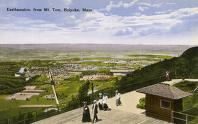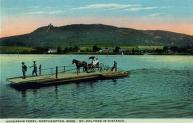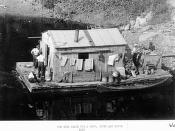|

Picnic, Mt. Sugar Loaf

Easthampton, from Mt. Tom, Holyoke, Mass.

Hockanum Ferry, Northampton, Mass. Mt. Holyoke in Distance.

"Holyoke Dam, Holyoke, Mass."

Connecticut River, Holyoke, Mass.

Logging at the Oxbow on the Connecticut River near Holyoke, Mass.

Log Driving on the Connecticut River

Log Drive Cook Shack on Connecticut River
|
Summary and Objective
Students will understand that water was a vital part of the communities located in western Massachusetts. As students take a picture walk looking at various uses of the Connecticut River, a town near where they live, they will see the value of the river in terms of economics (water power), transportation (for goods and people), and recreation. Students will show understanding of this concept as they use skills to write a paragraph using proper paragraph form.
Teaching Plan
Step 1.
As a class, students brainstorm what they already know about the Connecticut River (where it is located, when they have driven on a bridge over the Connecticut River, or used the river for some other purpose such as fishing or recreation).
Step 2.
Teacher lists the ideas on the flip chart under the heading: Connecticut River.
Step 3.
Teacher has taped pictures around the room depicting uses of the Connecticut River in the late 1800's-early 1900's (pictures have been enlarged and laminated for future use).
Step 4.
Students are put into groups of 2-3 students each. The teacher will assign groups to start in a location of the room, facing a certain image of the Connecticut River.
Step 5.
Student groups are given 2 minutes to look at each picture and discuss it quietly with group members. Next to each picture will be a guided question. Next to picture 1-"What are the people doing near the river here?" Picture 2-"How do you think the individuals in the picture got to the top of this mountain?" Picture 3-"How did the horse and carriage get across the river, and why?" Picture 4-"How is the dam providing power for the mill or factory in the background?" Picture 5-"Why would these ladies be sitting here?" Picture 6 and 7-"Why are there cut logs in the river, and what might they be used for?" Picture 8-"There is a man on this boat cooking. He will deliver food to loggers on the Connecticut River. Do you think this indicated long working hours on the river?" After 2 minutes the groups are rotated. Each image will be viewed.
Step 6.
Students come back to the rug to discuss their new findings about the Connecticut River in the late 1800's and early 1900's. Teacher again makes a list of thoughts on the flip chart.
Step 7.
Students compare and contrast current uses of the Connecticut River to past uses of this river.
Step 8.
At their seats, students will use correct paragraph form (see Paraburger writing instructions) to tell of the uses of the Connecticut River during the Progressive Era.
|




